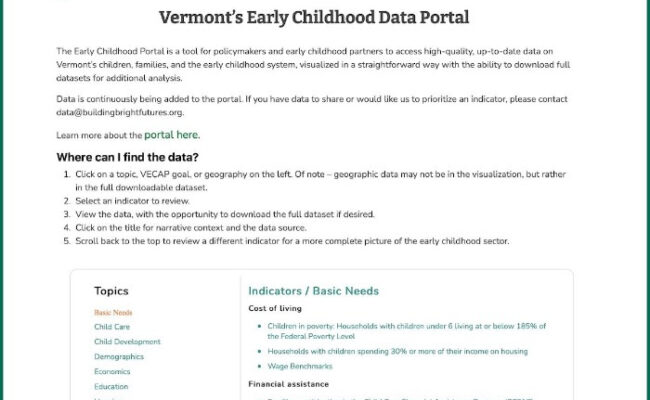
We’re excited to announce that we’ve just launched an Early Childhood Data Portal as part of VermontKidsData.org. The portal has indicators across all sectors that impact children and families: basic needs, child care, child development, demographics, economics, education, housing, mental health, physical health, resilience, prekindergarten education, and workforce.
Search the portal by topic, geographic region, or VECAP goal. This is a tool for policymakers and early childhood partners to easily access high-quality, up-to-date data on Vermont’s children, families, and the early childhood system.
Visit the Early Childhood Data Portal
What does the portal offer?
The portal allows partners to visualize data across all sectors related to Vermont’s children, families, and the early childhood system in a straightforward way, with the ability for anyone to download full datasets for additional analysis.
This tool puts data in context by analyzing trends over time, providing a snapshot of the most up-to-date data, often comparing Vermont to the U.S., and highlighting disparities and inequities.
While the portal prioritizes data for children from the prenatal period to age 8, limitations in data availability may mean that some indicators have a more limited or wider focus extending into middle childhood and adolescence. Indicators reflect both population-level outcomes and more specific program indicators. Data is continuously being added to the portal.
Why is the portal important?
Access to high-quality, up-to-date data allows us to respond more efficiently and effectively to the needs of children and families statewide and monitor how policies and program investments and decisions impact short- and long-term outcomes. Consistently reviewing data also allows the entire system (policymakers, agency leadership, community partners, and families) to identify where there are gaps in the system, where duplication exists, how resources are (or are not) successful in impacting outcomes, what to prioritize, and how to evaluate progress.
Where does the data come from?
Indicators are ever-evolving and compiled through partnership with state agencies and direct service providers in Vermont, alongside indicators from national datasets to understand the drivers of well-being and the impact of relevant programs and policies. Contributions and sources are named on each indicator page.
If you have data to share or would like us to prioritize an indicator, and for further information, please contact data@buildingbrightfutures.org


